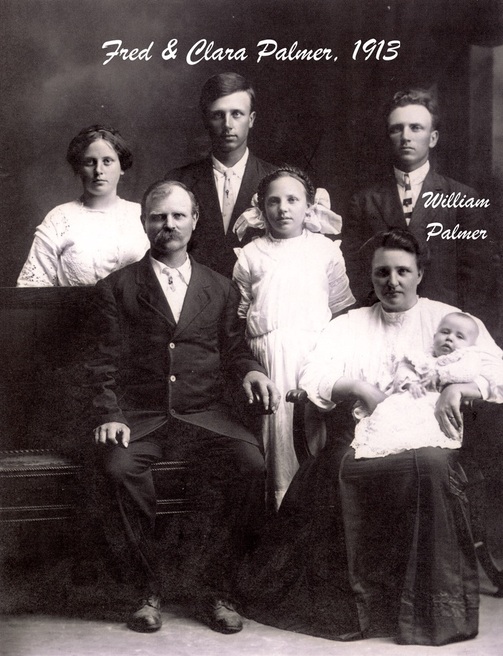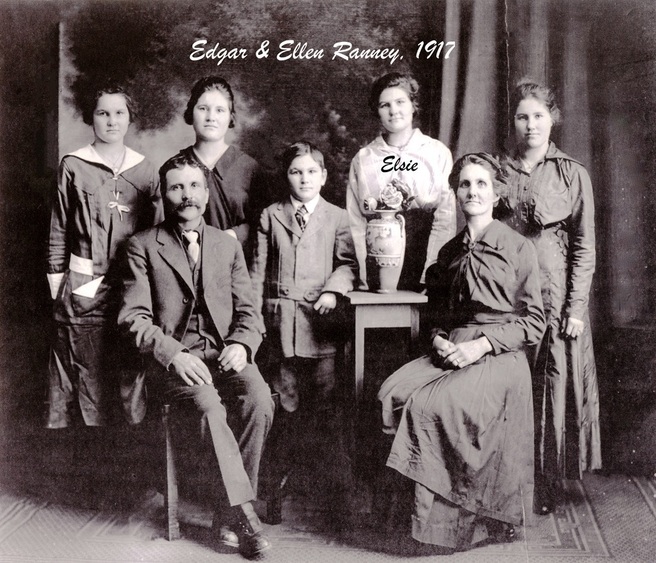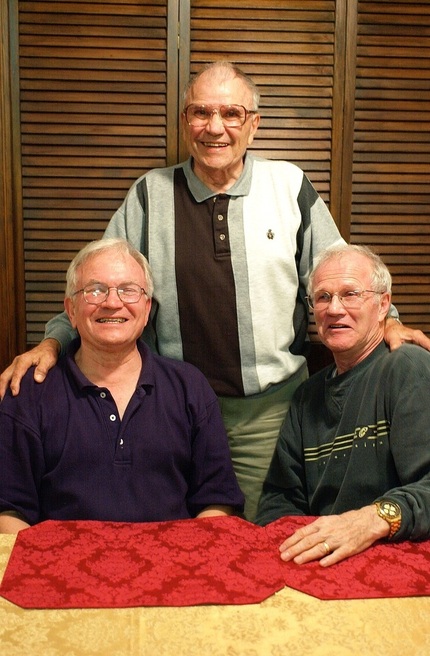A very important aspect of Glenn's life was his relationship with his brothers -- Wayne and Keith -- aka “The Brothers”. They grew up in a small northern Wisconsin city and while they had many similar childhood and young adult experiences, over their lifetimes, they grew into strikingly unique people -- with very different belief systems and life focuses. These differences could have easily created great distance between the brothers, but in the bigger picture, they added tremendous richness to the narrative of their lives and the love they had for each other.
Please note, the home page of this memorial site has an overview of Glenn’s life (
About Glenn). If you haven’t read that you might do so first as information there won’t be repeated.
This then, is the story of "The Brothers".
William Allen Palmer (Bill) and Elsie Faye Ranney were married in 1920 after William returned from World War I and settled in Wheeler, Wisconsin, population 300. Bill was a rural mail carrier delivering the mail (at first by horse, later by car) and later in retirement, started a Schwinn bicycle dealership in the basement of their house. Elsie was a housewife and had her hands full raising the kids. Wayne was born in 1921 and Keith in 1926 and Glenn, the youngest was born in 1935. In 1940, the family moved to Ladysmith, Wisconsin, with a rousing population of 3500. Ladysmith is located in northwest Wisconsin and the town grew up on two major industries, logging and farming. The mouth of the Flambeau River lies near Ladysmith and was an ideal spot from which to float logs down to mills at Eau Claire and Chippewa Falls. The logging industry fell off sharply after 1915, and farming then rose to take its place and is still the major industry of the area today. Bill was an avid hunter and fisherman and he used to take a shotgun with him on his mail route to shoot pheasant or other game he saw along the way and bring it home for dinner. He instilled his love of the outdoors in his sons. Elsie and Bill, as sometimes practicing Methodists, tried to ingrain religious beliefs in their kids but had quite varied success as you will see. Although money was tight and jobs were scarce amid the great depression, life in rural northern Wisconsin was generally uncomplicated for Wayne, Keith and Glenn, and might have even been called idyllic.
Given the rural environment and their father's outdoor hobbies, all three brothers grew up with a common love of the outdoors. Hunting and fishing were a constant part of their early lives and continued in the early part of their adult lives. Sports were especially important for them and a common love. Wayne played football, basketball and baseball in high school and began a lifetime love of racketball. Keith also played football, basketball and baseball, but additionally, was an active member of the ski jump club, and started his long term obsession with golf. Glenn played baseball and developed a passion for both golf and tennis which he played his entire his life. Glenn and Keith had many a competitive match of golf and although meaningful money was at stake, bragging rights and pride were the more important spoils going to the winner.
Service to their country, as it was with many of the men at the time, was an important, shared focus for the brothers.
Glenn’s Story on the front page of this web site, already covered the background of Glenn’s military service so it won’t be repeated here (if you haven’t read it yet, please do so).
After graduating high school in 1940, Wayne tried to enlist for WWII but was turned down due to poor eyesight. He then went to college at Stout University in Menominee, Wisconsin for 2 years studying drafting and shop, but in the wonderful way our government sometimes works, he was drafted by the Army in 1942. He trained to be a medic and was first stationed in Algeria, North Africa and given a desk job. This bored him and since one of his duties was maintaining the lists of who was assigned to which divisions -- he assigned himself to the Big Red One, the fighting First Infantry Division. He then saw action as a medic in the invasion of Sicily, the invasion of Europe (he was in the first wave at Omaha beach), and mainland European battles including the Battle of the Bulge. He returned in 1945 as a Staff Sergeant and a war hero with 4 purple hearts, 2 silver stars, 2 bronze stars, 2 presidential citations and a watch from the Swiss government for being the most decorated man in the 1st Infantry Division.
After graduating from high school in 1943 in the middle of his senior year, Keith went to Minneapolis to enlist in the military to serve in WWII. However, his poor vision, like Wayne when he first tried, made him ineligible. However, the Merchant Marines had a recruiting station next door and they weren’t concerned about the quality of his vision. He was allowed to sign-up as a mariner, but since he was not yet 18, his parents had to sign a waiver for him, which they reluctantly did. The Merchant Marines took him on many adventures throughout the South Pacific, the Horn of Africa and Australia as documented in highly entertaining letters he wrote home to his mother. Keith was blessed with a great gift of humor and writing talent and later in life published a book of tremendously funny stories from his life titled
"Episodes…..Old Oriental Curse: May you live an interesting life.” After WWII ended in 1945, Keith returned and moved to Fond du Lac, Wisconsin to work for the Soo Line Railroad and also attended Oshkosh State Teachers College (Now UW Oshkosh) for a semester. But the Korean War started in 1950, and any male between the ages of 18 - 26 was eligible for the draft. Keith was 25, and assumed that he would again not qualify for the service due to his poor vision, but he made a very flippant remark to the person giving the eye exam and consequently was given a “passing” vision score. Therefore, in a twist of fate, he once again served his country, this time as an Airman 1st Class, stationed in London maintaining radar systems for B45 bombers. When he returned in 1953, he was recognized as a war veteran, but was only credited for his two years of service in the Korean War, not his time in the Merchant Marines. (It took until the Schumacher Act of 1988 for this error to be fixed and he was given the proper veteran recognition due him.)
All totaled, the brothers dedicated over 11 years of their combined lives in service for their country. And then, like the rest of the greatest generation, the brothers got on with building the rest of their lives and it is during this time that their paths greatly diverged.
Upon return from service in 1947, Wayne quickly married his high school sweetheart Betty Jane Nelson in 1946 in Ladysmith, Wisconsin. They settled in Ladysmith where they had daughters Debbie (1952) and Sandy (1954). Wayne had a short stint working for the railroad in Ladysmith while Betty worked as a receptionist for an optometrist. The family moved to Oshkosh in 1955 where they had son Craig (1960) and there, Wayne spent the rest of his career working for 2 companies -- The Radford Company and Morgan Company -- running a commercial sales department for windows and doors. Betty gave up work and focused primarily on raising the kids. Both Wayne and Betty were very active, senior members of the Church of Christ and in fact had founded the church in their basement when they first moved to Oshkosh when they couldn't find one to their liking. Given their religious beliefs, neither Wayne or Betty drank any alcohol, although in her later years after Wayne passed, Betty was known to have her arm twisted by her son Craig to have a glass or two of wine which she learned to enjoy very much. Wayne continued his occasional hobbies of hunting and fishing for some years, but shifted primarily to racketball, played at the YMCA, where he was one of the top players. Both Wayne and Betty became lifetime (religious) republicans and likely never voted for a democrat. After the kids scattered to the 4 winds -- Craig to Colorado and then California, Debbie to Colorado and then Idaho and Sandy to Washington, South Carolina and finally Alabama -- Wayne and Betty moved to Daphne, Alabama in 2000 to be nearer Sandy and their grandkids Jesse and Caitlin. Wayne and Betty were together for 57 years at the time of Wayne's passing in 2003. Betty passed away in 2015.
After Keith returned from the Korean War in 1953, he settled back in Fond du Lac, WI. One Saturday he and his buddies drove to Milwaukee to see the Braves play (before they became the Brewers). After the game they went to a bar (Keith was rumored to like drinking very much!) where he met Carol Mary Danish who would only let Keith buy her a Coke; as she rarely drank because one drink would get her tipsy. Thus, begun a long-distance relationship that led to their marriage in 1955. The couple settled in Milwaukee where they had son Mark (1957), and daughter Patty (1958). Keith built a career in technical writing at Career Academy, Nordberg and P&H Harnischfeger advancing to Manager of Technical Publications and Carol worked as a salesperson for a local dress shop while raising the kids. Although Carol was a deeply religious Catholic prior to marriage (she had considered becoming a nun), she had a falling out with the church and afterward, religion ceased to be a key part of the family and Keith evolved into a disinterested agnostic. Keith hunted and fished occasionally but primarily continued to feed his passion for golf. He was an avid and educated reader, a conservative “Reagan” republican and political junkie often calling into local radio shows to air his views on local issues. In 1977, after Patty and Mark settled on their own in the Milwaukee area, Keith and Carol moved to Barrington, Illinois where Keith worked for International Harvester and Northrup Defense Systems again managing technical publications; and Carol worked in the Child Care Center of the YMCA. In 1990, Keith retired, and he and Carol moved back to Greendale, Wisconsin, to be nearer to Mark and Patty. Shortly thereafter they celebrated the births of their granddaughter (Kelly b.1990) and grandson (Christopher b.1991). Keith setup a consulting business -- Palmer Associates -- where he did contract writing. Keith and Carol were together for 57 years when Carol passed away in 2012. Keith passed away in 2017.
Glenn returned from military service in 1957 and focused on finishing his college studies as previously noted. In 1958, Glenn met Sue in 1958 under very strange circumstances. At that time Glenn was dating a girl who had a sister Coleen who did not know the two were dating. Glenn learned a lot about Coleen from her sister and decided to play a prank on Coleen by walking up to her in a bar and dancehall in Eau Claire called "The Hoot" and reciting facts about her that a stranger could not know. Sue was a friend of Coleen's and witnessed this strange man, Glenn, harassing her friend who didn't really appreciate it, so he certainly made a memorable, though not entirely positive impression on Sue. Although nothing came of it at the time, as fate would have it, they stayed in touch and started dating later that year. After graduation, Glenn and Sue taught class at local high schools and then decided to get married, and of course they did it in their own unique way -- which was to elope and not tell anyone. Unfortunately the secret slipped out 3 days before the wedding so in the end, both of their now greatly annoyed parents and siblings scrambled to attend the wedding at the local church which was not rescheduled.
As previously noted, Glenn and Sue spent 2 years in Nigeria and this began a lifelong love of Africa and African culture and their house is full of art and artifacts they brought home -- some of which would be impossible to get today. They both developed a lifetime passion for travel and learning about foreign culture. Unlike Glenn’s brothers, Glenn and Sue decided not to have children and raising a family was not a primary focus for them. They also developed a focus on healthy living in food and exercise which was often at great odds with their Wisconsin upbringing (no butter?!?) and Glenn’s brothers.
After moving to New Jersey and gaining access to the arts and cultural opportunities of the area, they became frequent attendees of Broadway and off Broadway plays in New York City and have visited almost every museum there -- many more than once. They both continued to play tennis while Glenn maintained his passion for golf. Given their life experience and the area they lived in, it’s not surprising they became liberal progressives -- very different than Glenn’s much more conservative brothers. Their diverse political views led to never ending debates between Glenn and Keith that continued throughout their lives. Glenn and Sue also were atheists -- with Glenn once declaring at a family dinner that Jesus was just an ordinary man, and in fact was a rabble rouser, much to the horror of his parents and his brother Wayne.
After they both retired they continued their lifelong passion for learning and education. They were voracious readers, and they began auditing college classes at nearby Princeton -- almost every semester. Glenn said auditing was the best of both worlds because you could learn about topics you liked, but you didn't have to take the tests.
When you step back and look closely at the people the brothers had become, the differences are striking. From The very religious (Wayne) to the agnostic (Keith) and atheist (Glenn); from conservative republican (Keith) to religious republican (Wayne) to progressive liberal (Glenn); from kids (Keith, Wayne) to no kids (Glenn). From extensive international travel, experience in foreign cultures and passion for the arts (Glenn) to limited focus on these aspects (Wayne, Keith)...... the differences between the brothers was quite immense. In today's supercharged political environment, the differences in their politics might be enough to keep them apart, much less their differences in interests and lifestyle. But even with these differences, there never was a time when the brothers didn't love each other deeply and over their lifetimes, their uniqueness became something to celebrate as opposed to something to keep them apart.
With Glenn's passing, his marriage to Sue of 59 years surpasses both Keith's and Wayne's and it closes the book on this band of brothers' lives, though Glenn's legacy lives on.




